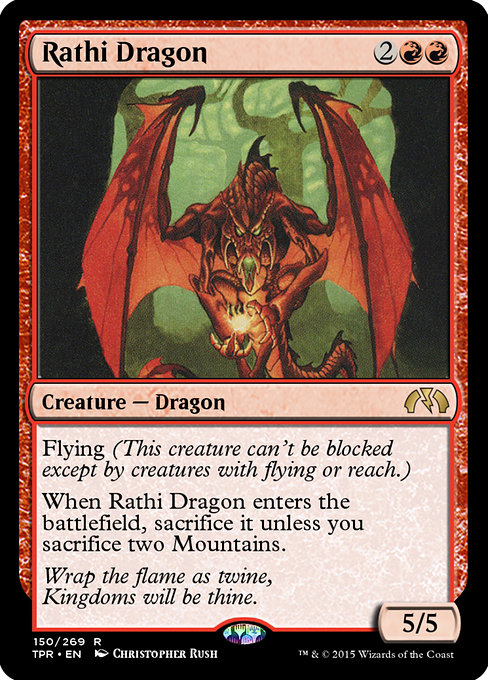
Image courtesy of Scryfall.com
Templating and Understanding in MTG: A Red Dragon Example
Magic: The Gathering has always trusted its players to read quickly, decide boldly, and adjust on the fly. But the way card text is templated—the punctuation, the order of the clauses, the very verbs chosen—can steer our understanding just as much as the rules themselves do. Rathi Dragon, a red dragon from Tempest Remastered, is a textbook case. It showcases how a single line of rules text can balance payoff and risk, while nudging players toward particular lines of play. 🧙🔥💎
Consider the dragon’s mana cost and body first: cost {2}{R}{R} for a 5/5 flyer is nothing to sneeze at. The keyword Flying is the public-facing mechanic that fans memorize instantly. But the real lesson hides in the triggered ability printed right after the creature’s stats:
When this creature enters, sacrifice it unless you sacrifice two Mountains.The phrasing is deliberate, compact, and instructive. It tells you, in a single breath, that you’re not getting a free 5/5 flyer; you’re entering into a conditional investment. The card’s templating makes you schedule a potential two-land sacrifice the moment the dragon appears on the battlefield. ⚔️
What the text is really saying—and what it asks you to do
The ETB trigger is two parts in one line. First, the dragon “enters” and you have a decision point. Second, the decision to sacrifice two Mountains becomes a conditional path to keep the dragon alive. In plain terms: either you sacrifice the Dragon immediately when it ETBs, or you sacrifice two Mountain lands to keep it. If you can’t or don’t want to sacrifice two Mountains, the dragon dies as it enters. That tiny conditional clause is what templating often aims for: readability at a glance, with a nuanced cost for continued presence on the battlefield. The use of the plural “Mountains” explicitly signals “two separate Mountain lands,” which players immediately translate into needing two resources to defer the loss. The double-syllable rhythm of the line mirrors the cadence of a high-wire decision in a live match. 🧭
Nuance extends beyond the literal costs. The dragon’s flavor text—“Wrap the flame as twine, Kingdoms will be thine.”—emphasizes ambition and control, a thematic throughline that designers weave into templating to encourage a certain mindset. The combination of aggressive stats, flight, and a self-check that demands land sacrifice foregrounds a particular play style: tempo to midrange with a land-light posturing that can pay off when your Mountains double as both mana sources and liability counters. The card’s rarity as a rare, its color identity of red, and its Master set status all feed into a broader narrative about how templating guides deck construction and risk assessment. 🎨
Templates in practice: scanning versus deep reading
- The quick read: You see Flying and a beefy 5/5, which sounds great for a red aggro–midrange curve.
- The mid-reading: You spot the ETB trigger and realize you must plan for a two-mountain sacrifice if you want to keep the dragon around.
- The deeper read: You analyze whether your current mana base can support two Mountains by the time you want to attack or defend, and you consider whether you have other red permanents or fetches that can accelerate or hinder your plan.
These steps illustrate how templating nudges a player’s cognitive process. The structure is intentionally straightforward, but the implications ripple outward: a single card can steer a game plan, affect land-sourcing decisions, and even influence how you sequence your plays in the early turns. For new players, the line can be a stumbling block; for veterans, it’s a compact shortcut that rewards mental quickness and ritual reading—two crucial MTG skills. 🧙♀️
Design lessons: keeping clarity while preserving charm
From a design perspective, Rathi Dragon demonstrates how a few tokens (three elements, really: mana cost, creature type, and the ETB clause) can create a layered experience without overwhelming the player. The templating maintains consistency with other ETB-type effects—these are staple design motifs in red and in aggressive or midrange archetypes. Yet the card remains distinct because of the explicit “two Mountains” requirement. This choice invites players to consider their land base seriously, which in turn strengthens the sense that every card in the deck is a participant in a broader plan rather than a one-off tempo play. The result is a memorable, teachable card that can anchor a templating discussion in both casual chats and high-level theory. 🧠🔎
“Reading a card is more than reciting rules—it’s rehearsing the decisions you’ll make in real time.”
Templating in the wild: how this informs deck-building and play culture
Rathi Dragon sits in Tempest Remastered as a reprint that preserves a classic dynamic: big red bodies with a built-in cost of commitment. The templating here encourages players to lean into land-tax style thinking—how many Mountains can you realistically sacrifice to unlock a game-tilting 5/5 flyer? For collectors and players alike, this card is a reminder that templating matters not just for rules comprehension but for the social rhythm of a match. It’s a card that rewards practice, not just raw power. And that’s a big reason why drafts, cube builds, and commander tables alike love the layered decisions hidden in a single line of text. 🧩
As you plan your next MTG session, consider how you read the text on a card like Rathi Dragon. Do you see a threat that must be managed, or a potential engine that can punch through with the right land base? The answer might reveal more about your game style than you expect—and it’s exactly the kind of insight that templating can spark in a way that’s as enjoyable as it is educational. 🎲